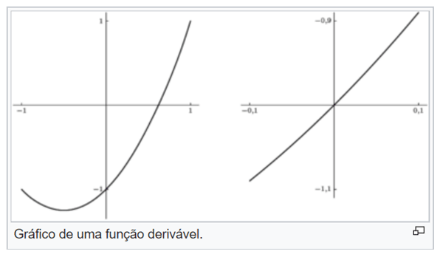13 Variables Derivative
By Samuel Eduardo da Silva, IFSULDEMINAS/UFF  Brazil
Brazil
By Samuel Eduardo da Silva, IFSULDEMINAS/UFF  Brazil
Brazil
The derivative of a function y = f(x) at a point x = x0, is equal to the value of the trigonometric tangent of the angle formed by the geometric tangent to the representative curve of y = f(x), at the point x = x0, the derivative is the angular coefficient of the line tangent to the graph of the function at point x0.
The derivative of a function y = f(x) can also be represented by the symbols:
y', dy/dx ou f ' (x).
The derivative of a function f(x) at point x0 is given by:

In classical geometry, the line tangent to the graph of the function f in a was the only line that passed through the point (a, f (a)) that did not find the graph of f across, meaning that the line did not pass directly through the graph. The slope of the secant to the graph of f in the image above, which passes through the points (x, f (x)) and (x + h, f (x + h)) is given by the quotient of Newton:

An alternative definition is: The function f is differentiable in a if there exists a function φa of I in continuous R in a such that:

For example, if we consider the function f of R in R defined by f (x) = x² + x - 1, it is differentiable in 0. It is possible to observe in the image below the graphs of the constraints of that function at intervals [-1 , (1) and [-1 / 10,1 / 10] and it is clear that while the former is rather curved (and hence f (x) - f (0) is far from linear) is practically indistinguishable from a line segment (from slope 1). In fact, the more the graph is enlarged near (0, f (0)), the closer it is to being linear.

When we derive the derivative of a function, the result is also a function of x and as such can also be differentiated. Calculating the derivative again yields the second derivative of the function f. Similarly, the derivative of the second derivative is called the third derivative, and so on. We can refer to the subsequent derivatives of f by:

If f is a function with real values in R, then the partial derivative of f measures its variation in the direction of the coordinate axes. For example, if f is a function of x and y, then its partial derivative measures the change in f in the x-direction and y-direction. However, they (partial derivatives) do not directly measure the variation of f in any other direction, such as that along the diagonal line y = x. These are measured using the directional derivatives. We can calculate the derivative of a function with 13 variables by means of ... "fake news, ok? There's nothing derived here. " This exercise is just for everyone learning to read something without judging by the titles and long texts. Given the base and height of a triangle, show your area. "Or will you say you forgot how to calculate triangle area too? Paulo Gueedes! "
Two floating point values P and T (0 < P, T ≤ 100000.00000), up to 5 decimal places, which indicate respectively the base and height of any triangle.
Real value, with 5 decimal places, representing the area of the triangle, next to the fake message: "We conclude that, given the input limit, the answer would be: y = f (x) =". Two spaces after the ':'.
| Input Samples | Output Samples |
|
1232.34343 323.98566 |
Concluimos que, dado o limite da entrada, a resposta seria: y = f(x) = 199630.79976. |
|
4.32434 3.23232 |
Concluimos que, dado o limite da entrada, a resposta seria: y = f(x) = 6.98883. |
|
2398.32323 132324.12122 |
Concluimos que, dado o limite da entrada, a resposta seria: y = f(x) = 158678006.90563. |